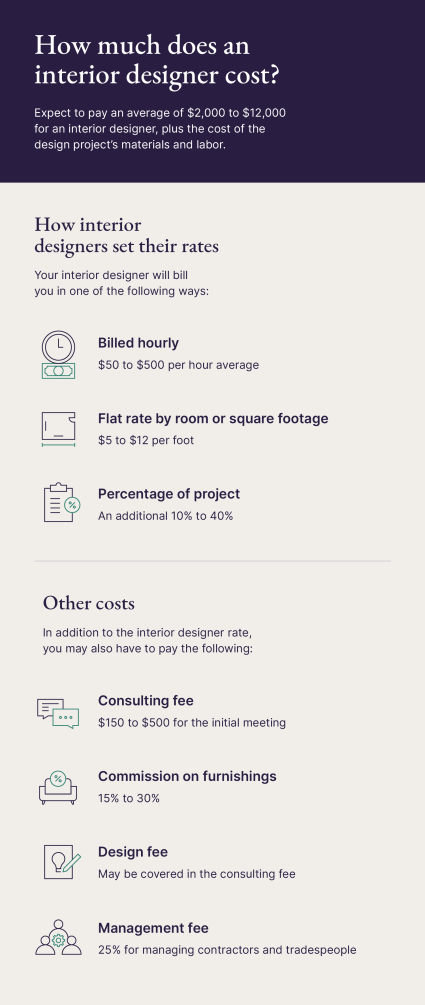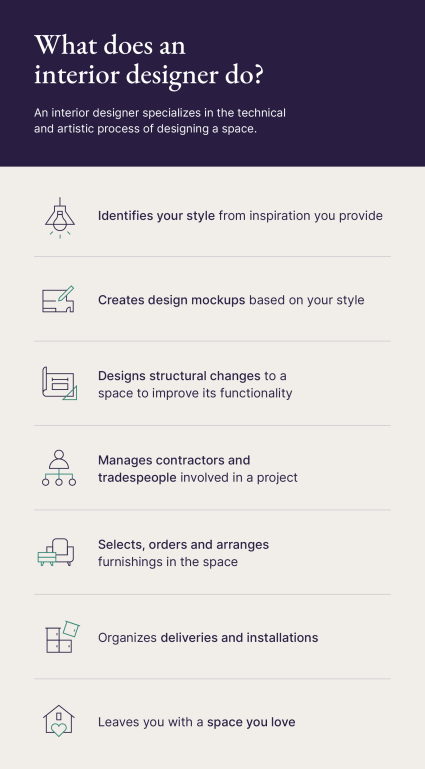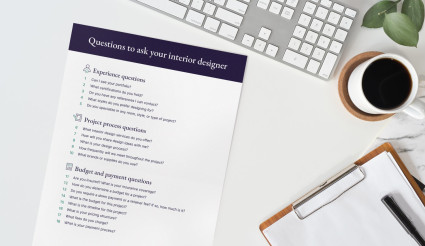Average cost for an interior designer
The average cost for an interior designer ranges from $2,000 to $12,000. This cost only covers the rate of the interior designer, and may not include any furnishings (like furniture, artwork, paint, etc.) — check with prospective designers to be sure.
Interior designer rates
Interior designers set their rates in varying ways. When first meeting with an interior designer, ask how they’ll charge for their services so you can budget accordingly.1. Hourly
Residential interior designers commonly charge by the hour. You can expect to pay anywhere from $50 to $500 per hour based on the designer’s credential level and years of experience. Your interior designer will bill you per hour for:- Site visits
- Communication with you and any contractors, tradespeople, etc.
- Shopping for furnishings
- Travel time (from their office to the site, for example)
- Any other time they devote specifically to your project
2. Flat rate by room/square footage
Designers at an interior design firm frequently charge a flat rate by room or square footage. The flat rate will include a set number of revisions but not furnishings, which would be added on at cost or on commission.If the designer charges by square footage, expect to pay anywhere from $5 to $12 per square foot with a minimum square footage requirement. This method is ideal for basic projects, but if your job requires any structural or custom elements, you’ll probably pay more in add-ons than you would if your designer billed you hourly or by percentage of project cost. However, this rate is the easiest to budget since you’ll know exactly what you’ll pay for the project upfront.3. Percentage of project cost
Some interior designers may set their rates as a percentage of the project cost. They’ll add up all the construction costs and then charge you an additional 10% to 30% as their design rate. This does not include the cost of furnishings.Others may also opt to use the cost-plus method to determine their rate. They’ll total the cost to complete the entire project, factoring in construction costs, permit fees, furnishings, etc., and then charge an additional 10% to 45% as their rate.4. Commission
Most interior designers can purchase furnishings at wholesale price, but they will charge you the retail cost, keeping the difference as commission. Others may buy furnishings at cost and bill you an extra 15% to 30%. Either way, expect to pay a commission fee on top of the hourly, flat rate or percentage of project cost rate. To verify the prices of your furnishings, ask your interior designer to keep receipts for all furnishing purchases.Factors that impact interior design cost
Regardless of how your interior designer sets their rates, several factors can impact how much you’ll pay for a design project:- Project scope: In general, the larger the square footage of your project, the more it’ll cost. A larger space will require more time and furnishings than a smaller one. If the project includes architectural or structural work, that can substantially increase how much your interior designer will charge.
- Materials: The number and quality of materials for the job will also directly impact your project costs. Availability of items and supply chain issues can also negatively affect your budget since waiting on a specific material can lead to costly delays. The way your designer charges for furnishings will also impact the cost.
- Room type: Some rooms are more expensive to renovate by nature. Kitchens require the purchase of expensive appliances that can drive up your costs, as can bathroom renovations that require plumbing.
- Location: Where you live also impacts how much you’ll pay for an interior designer. Interior designers in urban areas tend to charge more, as do those who travel long distances to get to you.
- Designer’s level of experience and reputation: The more experience an interior designer has, the higher the rate they’ll likely charge. However, a self-employed designer will probably charge less than a designer at a firm since their rates have to cover the overhead of the entire firm.
- Labor and additional fees: Labor fees vary by region and specific trade, impacting how much you’ll pay for an interior designer.
- Consultation fee: Before you agree to the project, designers will commonly charge anywhere from $150 to $500 for an initial consultation that includes a discussion of your design style and possibly a site visit.
- Design or mockup fee: Once the initial consultation is complete, some interior designers may charge an additional fee for any design images or mockups they create. Other designers may choose to include this service in their consultation fee.
- Management fee: If the project requires a contractor or tradespeople, an interior designer may charge a management fee of up to 25%.

What does an interior designer do?
Interior design refers to the technical and artistic process of designing a space that meets a client’s needs and style. Many people mistakenly refer to an interior designer as an interior decorator, but they are very different.An interior designer undergoes extensive training and holds a credential or license. An interior decorator does not. Additionally, interior designers focus on the functionality of a space, so they are involved from start to finish, even for structural changes. In contrast, interior decorators are only concerned with a space’s aesthetics, so they aren’t involved until the space is nearly completed.An easy way to remember the difference is that an interior designer may decide where walls will go, while an interior decorator will decide the paint color of an existing wall.It varies by interior designer, but in general, you can expect them to do any of the following:- Identify your design style if you don’t know it.
- Create one to three different design ideas based on your design style for you to choose from.
- Manage others involved in the project, from contractors to tradespeople.
- Find, order and arrange furnishings for the space.
- Organize deliveries and installations.
- Create a space that matches your style and lifestyle.
Benefits of hiring an interior designer
If it fits within your budget, hiring an interior designer offers many benefits.More experience and training
Thanks to their training, interior designers understand the functionality of space more than the average person. They also view design as an art form, so they know how to use lighting, texture, color theory and negative space to create the perfect room and home.Access to tools and deals
Perhaps the biggest benefit of an interior designer is their access to tools that simplify the design process, especially at the start of a project. In theory, anyone can pick a color scheme or a design aesthetic, but the end result is often not what they envisioned. Interior designers have tools that help them visualize a space before moving a wall or adding a coat of paint, saving you from making an expensive design mistake. In addition, interior designers can purchase from wholesalers you may not have access to.Increased resale value
An interior designer knows exactly what changes to make to a space for maximum return on investment. A professionally designed space often has a bigger wow factor than a DIY space, which can impress potential buyers. This is why so many realtors recommend homeowners get their homes professionally staged before putting them on the market. If you use an experienced interior designer, that can be a selling point for your home.Less stress and more time
Managing a home renovation can be a full-time job, especially if your project includes construction work. While any home improvement project comes with a certain amount of stress, hiring an interior designer will take that management off your plate, saving you time and stress throughout the project.How to pick the right interior designer for you
The key to a successful interior design experience is hiring the right interior designer for your style and project. To ensure you hire the right interior designer, follow these steps:- Determine the scope of the project. Decide exactly what you want and put together a wish list. Are you tackling the entire home or just focusing on a single room? Do you want a complete remodel or to just update the decor?
- Identify your style. Do some research on Pinterest and in home magazines. What do you like? Even if you can’t name the specific type of interior design, put together a Pinterest board or mood board to give the interior designer an idea of what you’re looking for.
- Set your budget. Think about how much you have to spend on the entire project — not just on the interior designer. This will help you narrow down your interior designer search.
- Ask for recommendations and read online reviews. Ask your friends, family and neighbors about local interior designers they’ve worked with. Check out those designers online and explore their social media to see their work.
- Choose an interior designer who matches your communication style and personality. While not a requirement, having a designer with a similar communication style as you can eliminate a lot of stress during the project. If working with someone who touches base with you frequently will help you trust the process, choose a designer who over-communicates. If you want a more hands-off approach to the project, opt for a designer who is OK with making decisions independently.

Questions to ask potential interior designers
Once you’ve narrowed your search, set up consultations with potential interior designer candidates. If you can cover the consultation fees, meet with several interior designers to explore your options. Otherwise, based on your research, schedule a consultation with the designer you like best.The point of the consultation is twofold: first, to determine if the interior designer is the right fit for your job, and second, to give the designer an idea of what you’re looking for and allow them to see the specific space.During the consultation, ask the following questions:Experience questions
- Can I see your portfolio?
- What certifications do you hold?
- Do you have any references I can contact?
- What styles do you prefer designing for?
- Do you specialize in any room, style or type of project?
Project process questions
- What interior design services do you offer?
- How will you share design ideas with me?
- What is your design process?
- How frequently will we meet throughout the project?
- What brands or supplies do you use?
Budget and payment questions
- Are you insured? What is your insurance coverage?
- How do you determine a budget for a project?
- Do you require a down payment or a retainer fee? If so, how much is it?
- What is the budget for this project?
- What is the timeline for this project?
- What is your pricing structure?
- What fees do you charge?
- What is your payment process?
How to save money on an interior designer
If you want the expertise of an interior designer but money is tight, consider the following strategies to make it more affordable:- Use an online design service to design the space and then implement the design yourself.
- Purchase the furnishings for the space directly to avoid paying a commission fee.
- If you have the necessary skills, help with the labor to lower labor fees.
- Instead of custom design elements, opt for mass-produced furnishings that are more readily available.
- Get the designs from a consultation with an interior designer and then manage the project yourself.
- Reuse or repurpose old furnishings instead of buying new ones.
- Focus on one space in your home at a time.


